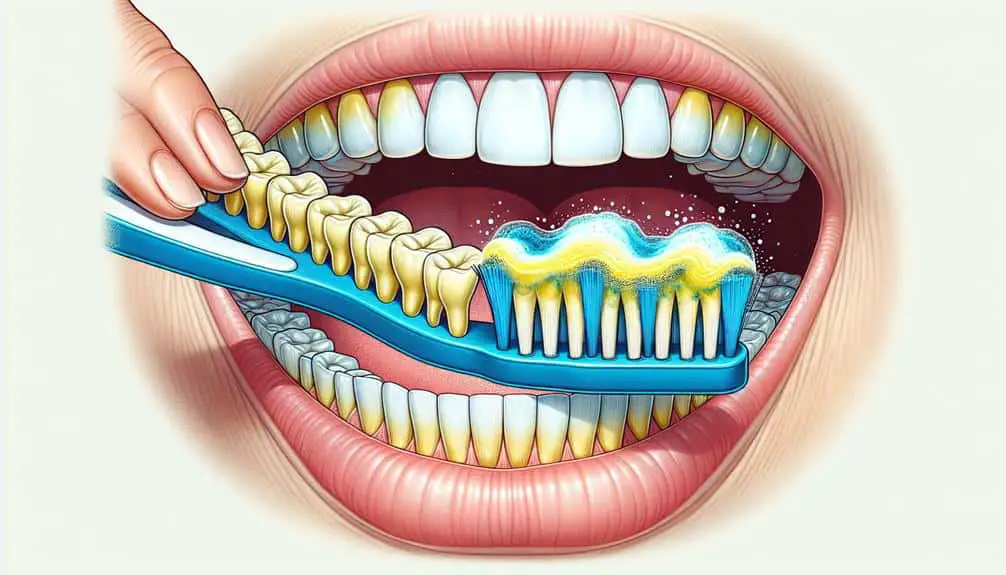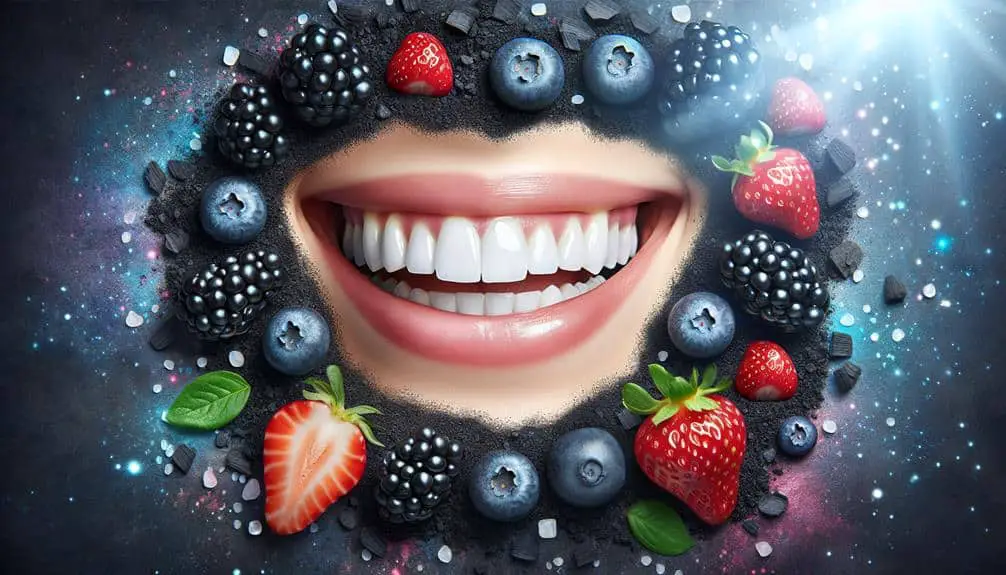To safely remove fluoride stains, try natural remedies like oil pulling, baking soda paste, or rubbing banana peel on teeth. A mix of hydrogen peroxide and water can also help lighten stains. Consider professional whitening treatments for efficient results. Lifestyle changes such as limiting fluoridated water intake and increasing calcium-rich foods can prevent staining. Follow safety precautions like proper brushing with fluoride toothpaste and avoiding teeth-staining foods. These tips provide effective ways to tackle fluoride stains on your teeth.
Key Points
- Oil pulling and baking soda paste are natural remedies for fluoride stain removal.
- Rubbing banana peel on teeth can reduce fluoride stains due to its mineral content.
- Hydrogen peroxide mixed with water serves as a stain-lightening mouthwash.
- Professional whitening treatments offer safe and effective solutions for stubborn fluoride stains.
- Implement lifestyle changes like limiting fluoridated water intake to prevent further staining.
Understanding Fluoride Stains
To understand fluoride stains, it's important to grasp the underlying causes and characteristics of these discolorations on your teeth. Fluoride stains, also known as dental fluorosis, occur when developing teeth are overexposed to fluoride, typically during childhood. This overexposure can lead to the appearance of white, brown, or yellow streaks or spots on the teeth, affecting their aesthetic appeal.
The primary cause of fluoride stains is the ingestion of excessive fluoride during the formative years of tooth development. This often happens through swallowing fluoride toothpaste or consuming water with high fluoride levels. While fluoride is essential for dental health, an excess can result in these unsightly stains.
Treatment options for fluoride stains depend on the severity of the discoloration. Mild cases can often be improved through professional dental cleanings and teeth whitening procedures. In more severe instances, treatments like dental bonding, veneers, or crowns may be necessary to restore the natural appearance of the teeth. It's important to consult with a dental professional to determine the most suitable treatment for your specific case.
Effective Home Remedies
If you're looking to address fluoride stains at home, there are several effective remedies you can try to help improve the appearance of your teeth. Natural remedies offer a gentle way to combat these stains without harsh chemicals.
One popular DIY solution is oil pulling, where swishing coconut or sesame oil in your mouth helps remove toxins and bacteria that contribute to staining. Baking soda mixed with water to create a paste can also be used as a natural scrub to gently polish away surface stains caused by fluoride.
Additionally, rubbing a banana peel on your teeth can provide minerals like potassium, magnesium, and manganese, which may help reduce stains over time. Another home remedy involves using hydrogen peroxide mixed with water as a mouthwash to help lighten stains gradually.
Remember to use these remedies in moderation and consult with a dentist if you have any concerns about their usage.
Professional Whitening Options
Considering professional whitening options as a solution for stubborn fluoride stains on your teeth can provide effective results under the guidance of a dental professional. Dental procedures like professional whitening treatments offer a safe and efficient way to address discoloration caused by fluoride. Cosmetic dentistry, specifically teeth whitening, is a common approach used by dentists to help patients regain a bright smile.
Professional whitening options generally involve in-office treatments that use high-concentration bleaching agents to target deep stains effectively. These procedures are typically faster and more potent than over-the-counter whitening products, ensuring noticeable results in a shorter time frame. Dental professionals have the expertise to customize the treatment to your specific needs, ensuring both safety and effectiveness.
Before opting for professional whitening, it's essential to consult with your dentist to discuss the best approach for your situation. With their guidance, you can achieve a whiter, brighter smile and successfully combat fluoride stains on your teeth.
Lifestyle Changes for Prevention
Implementing lifestyle changes is essential for preventing the recurrence of fluoride stains on your teeth. To maintain a healthy and stain-free smile, consider the following preventive measures and dietary changes:
- Limit Consumption of Fluoridated Water: Since fluoride in water can contribute to stains, consider using a water filter to reduce fluoride levels. Opt for bottled water or water sources with lower fluoride content to prevent staining.
- Increase Calcium-Rich Foods: Calcium helps protect your teeth from the effects of fluoride. Include dairy products, leafy greens, and almonds in your diet to enhance the strength of your enamel and minimize the risk of staining.
- Avoid Acidic Food and Drinks: Acidic foods and beverages can exacerbate fluoride stains by weakening enamel. Limit your intake of citrus fruits, sodas, and vinegar-based dressings to maintain a healthy pH balance in your mouth and prevent further staining.
Safety Precautions and Tips
Wondering how to safely remove fluoride stains from your teeth? When it comes to safety precautions and tips for tackling fluoride stains, proper brushing techniques are essential. Opt for a soft-bristled toothbrush and fluoride toothpaste to gently scrub away surface stains without causing damage to your enamel. Make sure to brush at least twice a day, focusing on each tooth individually to guarantee thorough cleaning.
In addition to proper brushing, consider making dietary changes to prevent further staining. Avoid foods and beverages that are known to stain teeth, such as coffee, tea, red wine, and berries. Opt for a balanced diet rich in fruits and vegetables that can help naturally cleanse your teeth and promote overall oral health.
Frequently Asked Questions
Are Fluoride Stains Permanent or Can They Be Completely Removed?
Fluoride stains aren't permanent; they can be removed with proper care. Regular brushing with fluoride toothpaste, professional whitening techniques, and stain prevention methods can help eliminate and prevent them. Take charge of your dental health today!
Can Fluoride Stains Reappear After They Have Been Removed?
Fluoride stains can reappear if proper prevention and maintenance aren't followed. Consistent oral hygiene, avoiding excessive fluoride exposure, and regular dental check-ups are key to preventing the recurrence of fluoride stains on your teeth.
Will Removing Fluoride Stains Weaken the Enamel of My Teeth?
You might think removing fluoride stains weakens enamel, but in reality, it can enhance enamel protection. Stain prevention measures like regular cleanings and avoiding acidic foods will safeguard your teeth. Be cautious with whitening treatments to prevent sensitivity.
Are There Any Long-Term Effects of Having Fluoride Stains on My Teeth?
Having fluoride stains on your teeth can lead to potential risks such as discoloration and weakening of enamel. To prevent long-term effects, consider safe removal methods and regular dental care to maintain oral health.
Can Children or Pregnant Women Safely Use the Same Methods for Removing Fluoride Stains as Adults?
When it comes to removing fluoride stains, children and pregnant women should prioritize safety. Guarantee methods are gentle, effective, and suitable for their specific needs. Consult with a dental professional to find the best approach for them.



